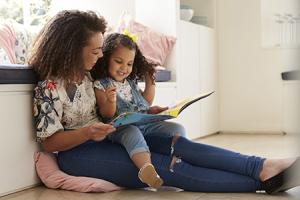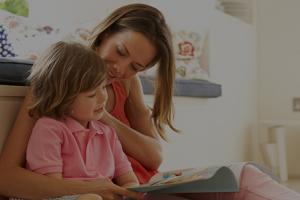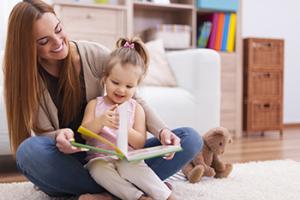This toolkit, developed in collaboration with the Idaho State Department of Education, helps parents and families use everyday time together as an opportunity for learning and building reading skills.
You will learn:
- Simple and effective ways to help students develop literacy skills.
- Ways to make reading a part of every day.
This toolkit includes:
- Videos
- Tools & Resources
- Recommended Books & Apps
Get Started
LET’S TALK
Talking, Listening, and Asking Questions Supports Language Development.
Parents can use everyday time together as an opportunity for learning and building language.
Three Steps to Support Language Development
1. TALK
Talk to your child about everyday life.
- I think we should have macaroni for dinner.
- Can you think of a vegetable we can have with our dinner?
- Look at that big sign with an arrow on it. What do you think it means?
2. LISTEN
Listen and repeat back what you hear your child say.
- I’m glad you thought recess was fun today.
- It sounds like you didn’t like your hot lunch.
3. ASK
Ask your child questions that can’t be answered with just one word.
- What books did you read in school today?
- Can you teach me how to play this game?
Mindful Minute: Let's Talk
Watch this video that demonstrates the three steps to support your student's language development. It only takes a moment!
Resources
APPS & ASSISTIVE TECHNOLOGY
You can pet and poke Tom, and even speak to him - he repeats everything you say in his cute, funny voice. (K-Grade 8)
A symbol-based communication app that gives a voice to those who cannot speak. (K-Grade 12)
A communication device that supports those with limited to no speech throughout their daily activities. (K-Grade 12)
BOOKS
"Drawn Together" by Minh Le (PK-Grade 2)
"Martha Speaks" by Susan Meddaugh (PK-Grade 2)
"Mercy Watson Goes for a Ride" by Kate DiCamillo (K-Grade 3)
Download the Let's Talk Pamphlet
CHECKING THE LIST
Building Vocabulary Through Conversation
Parents can use everyday time together as an opportunity for learning.
Three Steps to Build Vocabulary
1. TALK
Talk about what you are doing during everyday tasks.
- We need produce to make a salad.
- We need some small grape tomatoes.
2. ANSWER
Answer questions your child has about everyday activities such as grocery shopping.
- What kind of tomatoes do we need?
- Why do we call it produce?
3. SUPPORT
Activities like grocery shopping can be an opportunity for parents to support learning.
Farmers grow food and call it produce because they produce it.
Mindful Minute: Checking the List
Watch this video that demonstrates the three steps to build your student's vocabulary. It only takes a moment!
Resources
APPS & ASSISTIVE TECHNOLOGY
Learn new words and how they sound, as you build beautiful, animated scenes full of characters, animals, and objects. (PK-Grade 1)
This app helps children increase their vocabulary by taking players through an adventure. (Grade 4-8)
BOOKS
"Llama Llama Mad at Mama" by Anna Dewdney (PK-K)
"Chicken Butt’s Back!" by Erica S. Perl (K-Grade 2)
"Eating the Alphabet" by Lois Ehlert (PK-Grade 1)
Download the Checking the List Pamphlet
EVERY PICTURE TELLS A STORY
Practice Reading Comprehension with Picture Books
Reading picture books allows children to think out loud and create their own stories, which improves reading comprehension.
Three Reasons to Use Picture Books
1. SUPPORT
When a book does not have any words, it takes the pressure off struggling readers. They can get comfortable with the idea of “reading” without worrying about getting every word right. Positive interactions with stories can help them enjoy reading.*
2. BUILD
Because a picture book uses illustrations, this may help him or her better understand a book’s story line. Later on, this skill will help your child decode text and help him or her become a stronger reader.*
3. PROMOTE
Whenever you reread a picture book you can find a new story to tell. Seeing the same story through a different lens can unlock your child’s creativity and inspire your child to create stories of his or her own. A love of reading can grow from a great imagination.
Mindful Minute: Every Picture Tells a Story
Watch this video that demonstrates how to use picture books to improve reading comprehension. It only takes a moment!
Resources
APPS & ASSISTIVE TECHNOLOGY
App that targets sequencing skills by offering 38 sequences organized into categories: playing, mealtime, grooming, etc. (Grade 1-7)
BOOKS
“Journey” by Aaron Becker (Grades 1-4)
“Chalk” by Bill Thomson (PK-Grade 2)
“Goodnight, Gorilla” by Peggy Rathmann (PK-Grade 1)
Download the Every Picture Tells A Story Pamphlet
THE STORIES WE TELL
Building Knowledge Through Storytelling
Story telling is one of the oldest types of education for children.
Three Reasons To Build Knowledge Through Storytelling
1. SHARE
Through hearing and talking about topics that include different perspectives, your child learns to relate and carry that skill into his or her reading. Sharing family stories is a great way to build knowledge and support reading comprehension from home.
2. BUILD
Part of reading success for your child lies in building background knowledge for them to use during reading. Storytelling builds your child’s understanding of story elements that include character and setting.*
3. CONNECT
Storytelling also help your child learn to write stories and connect life experiences to what he or she reads.* Sharing family traditions and stories is a great way to build knowledge for your child.
Mindful Minute: The Stories We Tell
Watch this video that demonstrates how to use storytelling to build knowledge. It only takes a moment!
Resources
APPS & ASSISTIVE TECHNOLOGY
Make a social story or slide show! Each page in a Pictello story consists of a photo or video and some text, which can be read aloud by a Text to Speech voice or your own recorded audio. (K–Grade 12)
BOOKS
“One Family” by George Shannon (PK-Grade 2)
“Dreamers” by Yuyi Morales (PK-Grade 3)
“Tell Me Again About the Night I Was Born” by Jamie Lee Curtis (PK-Grade 2)
Download the The Stories We Tell Pamphlet
READING THE WORLD
Interactions Support Building Meaning for Reading Comprehension
Children who connect their life experiences to learning build knowledge of the world to use during reading.
Three Ways to Build Meaning Through Interactions
1. CONNECT
Connect to real life experiences.
- Watch the yellow triangle. That means we are turning the water off.
- When the water is little the water moves to the farms.
2. SUPPORT
Support vocabulary development by helping your child read difficult words.
- This is a big word, hydroelectric.
- Listen to me say it. Now you say it.
3. BUILD
Build knowledge from what your child already knows.
- What else grows on farms?
- Where did the water go?
Mindful Minute: Reading the World
Watch this video that demonstrates how to build meaning through interactions. It only takes a moment!
Resources
APPS & ASSISTIVE TECHNOLOGY
Expeditions explore history, science, the arts, and the natural world. Whether you’re roaming with dinosaurs or taking a look at Renaissance sculptures, there’s something amazing to explore for every subject. (K–Grade 12)
BOOKS
“A River” by Marc Martin (PK-Grade 3) “The Biggest Puddle in the World” by Mark Lee (PK-Grade 2) “Over in a River: Flowing Out to the Sea” by Marianne Berkes (PK-Grade 1)
Download the Reading the World Pamphlet
COOKING UP UNDERSTANDING
Simple Interactions Can Build Reading Skills
Cooking with a recipe teaches children to follow directions in order and supports reading comprehension.
Three Steps to Build Reading Skills
1. PREVIEW
Preview what will be in the text before you start reading together. I don’t think we have two cups of all these ingredients.
2. DISCUSS
Discuss what is happening in the text during reading. The first ingredient is raisins.
3. SUMMARIZE
Summarize or tell what happened in the story after reading. So we added our ingredients and mixed them together.
Mindful Minute: Cooking Up Understanding
Watch this video that demonstrates the three steps to build reading skills. It only takes a moment!
Resources
APPS & ASSISTIVE TECHNOLOGY
Is your little one an aspiring chef? Download Issa’s Edible Adventures today and explore the excitement of a working restaurant kitchen while learning about foods from around the world! (PK-Grade 1)
BOOKS
“Thank You Omu!” by Oge Mora (PK-Grade 2) “Stone Soup” by Marcia Brown (K-Grade 4) “The True Story of the 3 Little Pigs” by Jon Scieszka (rhymes with Fresca) (Grade 1 up)
Download the Cooking Up Understanding Pamphlet
Playing with Sounds
Singing and Rhyming Support the Development of Early Reading Skills
One of the most important skills children must have to be a successful reader is the ability to hear sounds and play with words.
Three Activities to Develop Early Literacy Skills
1. SING
Sing silly or real songs with your child. I like to eat eat eat ee-pples and bee-nee-nees.
2. RHYME
Say simple rhymes with real words or make believe words.
- Cat-hat-blat
- Wog-dog-vog
3. PLAY
Play with words by changing or taking out sounds. I like to ote ote ote opples and bo-no-nos
Mindful Minute: Playing with Sounds
Watch this video that demonstrates the three activities to develop early literacy skills. It only takes a moment!
Resources
APPS & ASSISTIVE TECHNOLOGY
This interactive app helps individuals identify the different sounds that make up words in a fun and engaging way by providing rhyming activities. (PK-Grade 1)
BOOKS
“Polar Bear, Polar Bear, What Do You Hear?” by Bill Martin (PK-Grade 2) “Tap, Tap, Bang, Bang” by Emma Garcia and the rest of the similarly titled series (PK to K) “Down by the Bay” by Raffi (PK-Grade 3)
Download the Playing with Sounds Pamphlet
TECHNOLOGY FOR LEARNING
Teach Early Literacy Skills to Support Reading Success in School
Technology can support learning for children of all ages, including helping young children get ready for school.
Three Skills to Teach for Early Literacy Success
1. LETTERS
Help your child identify letters by name.
- The letter is h.
- Touch the letter h.
2. SOUNDS
Support your child to read words by listening to the sounds the letters make.
- Now you have to read the word.
- What is the sound of this letter?
3. WORDS
Read words to your child that they can repeat to learn that words carry meaning.
- The word is bump.
- What is the word?
Mindful Minute: Technology for Learning
Watch this video that demonstrates the three skills to teach for early literacy success. It only takes a moment!
Resources
APPS & ASSISTIVE TECHNOLOGY
This interactive app introduces children to letters and the sounds they make in a fun and interactive way that builds foundation reading skills necessary for reading success. (PK-Grade 2)
BOOKS
“Not a Box” by Antionette Portis (PK–Grade 2) “Unplugged” by Steve Antony (PK–Grade 1) “Oh no!, or How My Science Project Destroyed the World” by Mac Barnett (K–Grade 3)
Download the Technology for Learning Pamphlet
READING FOR FUN!
Reading Aloud Together to Improve Comprehension
Reading with your child can improve and build his vocabulary and comprehensions skills.
Three Strategies for Reading Aloud
1. MODEL
Model reading from left to right by moving your finger under the words. Watch me read these words.
2. ASK
Ask questions about pictures and words as you read.
- What is this picture showing?
- This is a horse, what is this?
3. SUPPORT
Support students by helping them sound out words.
- What word is this?
- The word is…
Mindful Minute: Reading for Fun!
Watch this video that demonstrates the three strategies for reading aloud. It only takes a moment!
Resources
APPS & ASSISTIVE TECHNOLOGY
This app has over 1100 titles for grades K-6, and includes unique animated, talking picture books, read-along chapter books, national geographic videos, non-fiction books, playlists, and graphic novels. (K-Grade 6)
BOOKS
“Pete the Cat: I Love My White Shoes” by Eric Litwin (PK- Grade 1) “Mother Bruce” by Ryan T. Higgins (PK-Grade 1) “Princess in Black” series by Shannon Hale (K-Grade 3)
Download the Reading for Fun! Pamphlet
The information and resources in this toolkit were gathered through multiple partnerships including the National Center on Improving Literacy, Idaho Public Television, Idaho Commission for Libraries, Idaho Association for the Education of Young Children, and Idaho Parents Unlimited.
Explore More Toolkits
This toolkit helps parents and families take part in literacy experiences at home to develop children’s reading and language skills.
This toolkit helps teachers and families understand what the alphabetic principle and phonics are and how to support a child's development of these important reading skills.
This toolkit helps parents and families understand the many different skills involved with teaching your child to learn to read and how to support your child's reading development at school and home.
The research reported here is funded by awards to the National Center on Improving Literacy from the Office of Elementary and Secondary Education, in partnership with the Office of Special Education Programs (Award #: S283D160003). The opinions expressed are those of the authors and do not represent views of OESE, OSEP, or the U.S. Department of Education. Copyright © 2024 National Center on Improving Literacy. https://improvingliteracy.org


